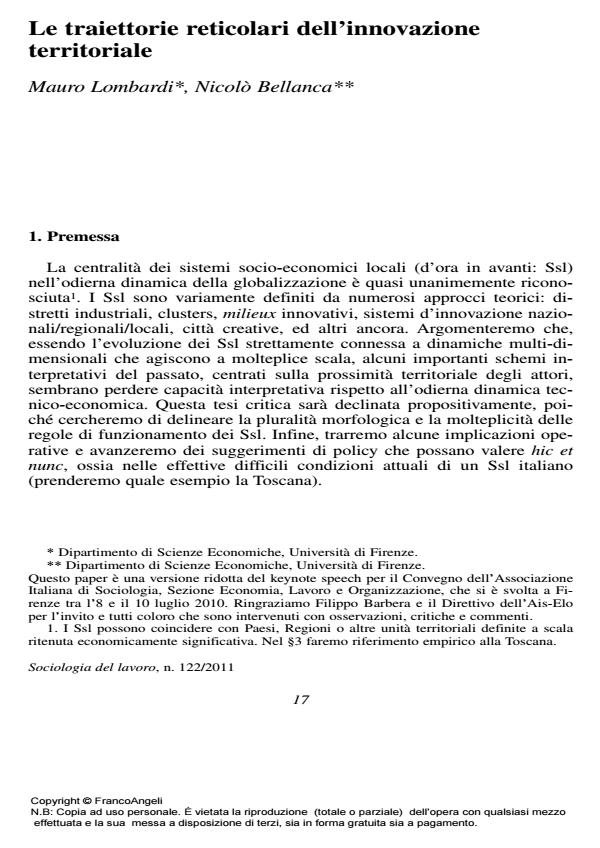The reticular paths of territorial innovation
Journal title SOCIOLOGIA DEL LAVORO
Author/s Mauro Lombardi, Nicolò Bellanca
Publishing Year 2011 Issue 2011/122
Language Italian Pages 14 P. 17-30 File size 282 KB
DOI 10.3280/SL2011-122002
DOI is like a bar code for intellectual property: to have more infomation
click here
Below, you can see the article first page
If you want to buy this article in PDF format, you can do it, following the instructions to buy download credits

FrancoAngeli is member of Publishers International Linking Association, Inc (PILA), a not-for-profit association which run the CrossRef service enabling links to and from online scholarly content.
Traditions of studies dating back to Marshall, Porter and Krugman interpreted Local socio-economic systems (Lss) mainly considering the spatial proximity of the actors. It was the local anchorage that enabled an increase in specific forms of external economies, competitive advantages and endogenous dynamics. Therefore, in the last decades, these local systems have gone through multiple changes in a multi-dimensional scale. The new structural connotations - including cognitive proximity, the task-based competition, the complementarity of formal contracts and informal agreements in business partnerships, trans-local networks - require a different theoretical framework and involve different policy implications. The theoretical framework focuses on co-evolution of technologies, organizational models, cultures and institutions. Among the multiple trajectories made possible by the co-evolution, each Ssl is both related to a socio-technical system that restricts its dynamics of change, and plugged into paths along which can access in a discontinuous way to far techno-economic horizons. Therefore the policy implications must refer to innovative trajectories that the existing global socio-technical transition makes possible for a specific group of Ssl, which is Tuscany in our case. At the strategic and operative level - considering political and social limits of the society we are considering - we try to catch some "bottlenecks" which obstruct the perception and the pursuit of longterm collective interests. These blocks relate to myopia, both of entrepreneurs and of public institutions, in respect of the scientific-technical potential and effectively evolutionary paths that would be convenient to take; the inadequacy of institutional forms within which commons are produced and managed; the lack of appropriate ways to capitalize innovative enterprises. For each of these lock-in we make constructive and viable proposals.
Keywords: District, local socio-economic system, socio-technical transition, lockin, Tuscany
- Physicality e path dependence nella transizione post-metropolitana in Toscana Giancarlo Paba, Camilla Perrone, in TERRITORIO 76/2016 pp.52
DOI: 10.3280/TR2016-076007 - La forza delle comunità locali (ISBN:979-12-215-0177-3)
Mauro Lombardi, Nicolò Bellanca, Le traiettorie reticolari dell’innovazione territoriale in "SOCIOLOGIA DEL LAVORO " 122/2011, pp 17-30, DOI: 10.3280/SL2011-122002